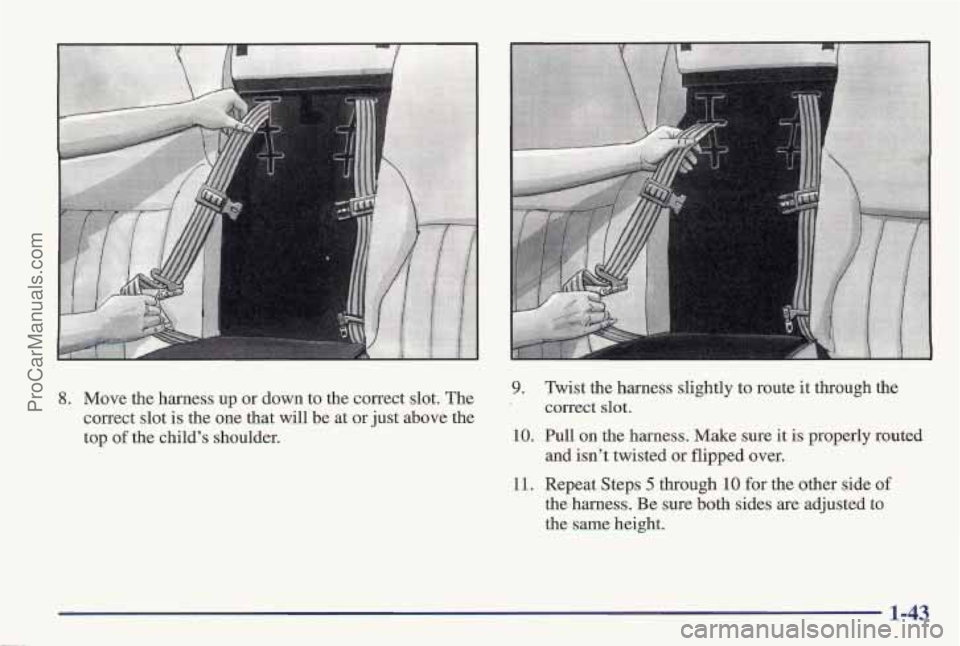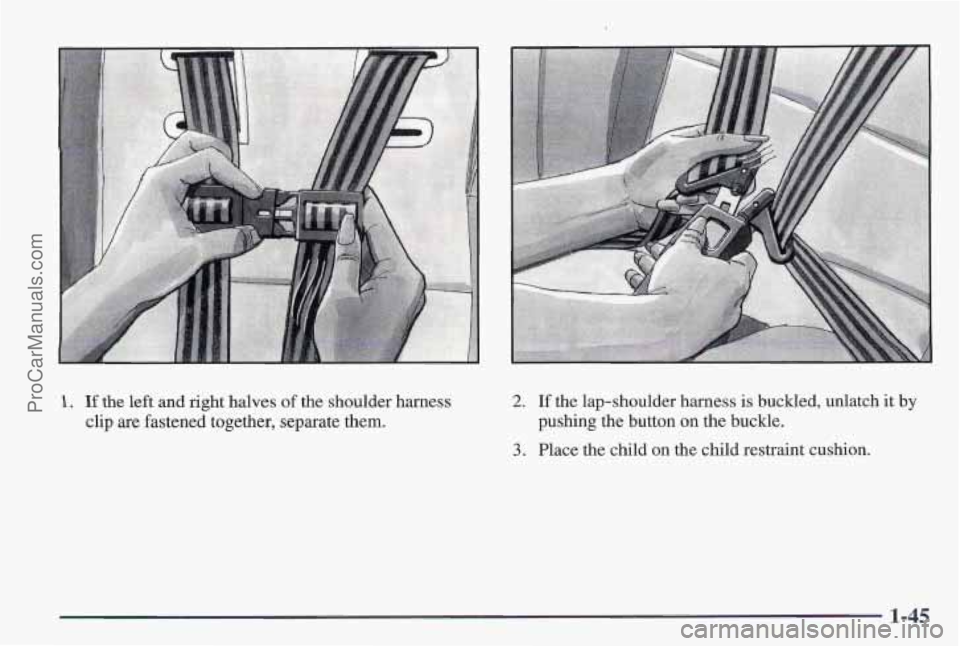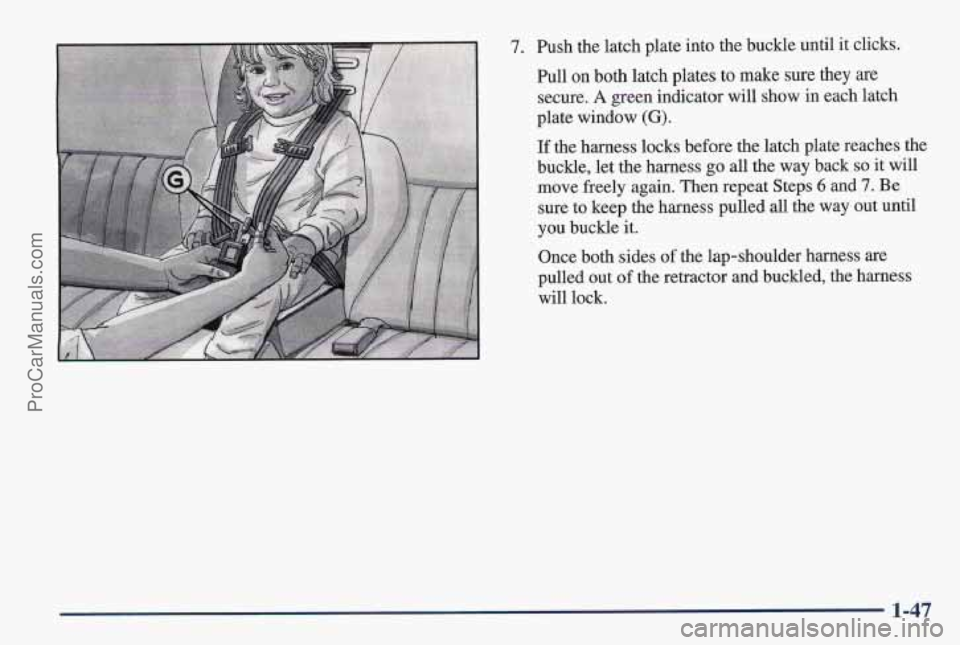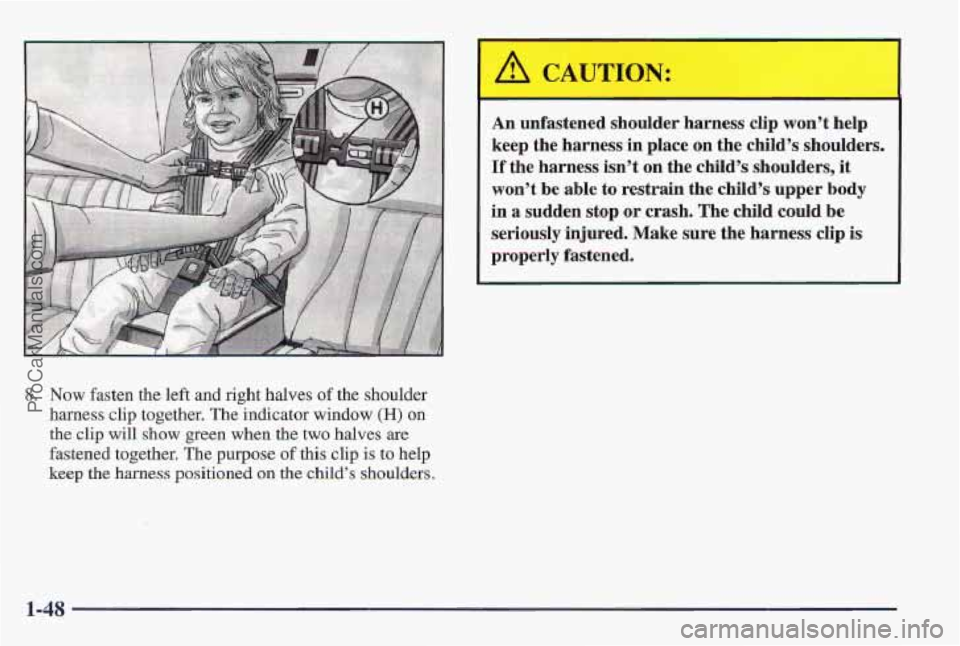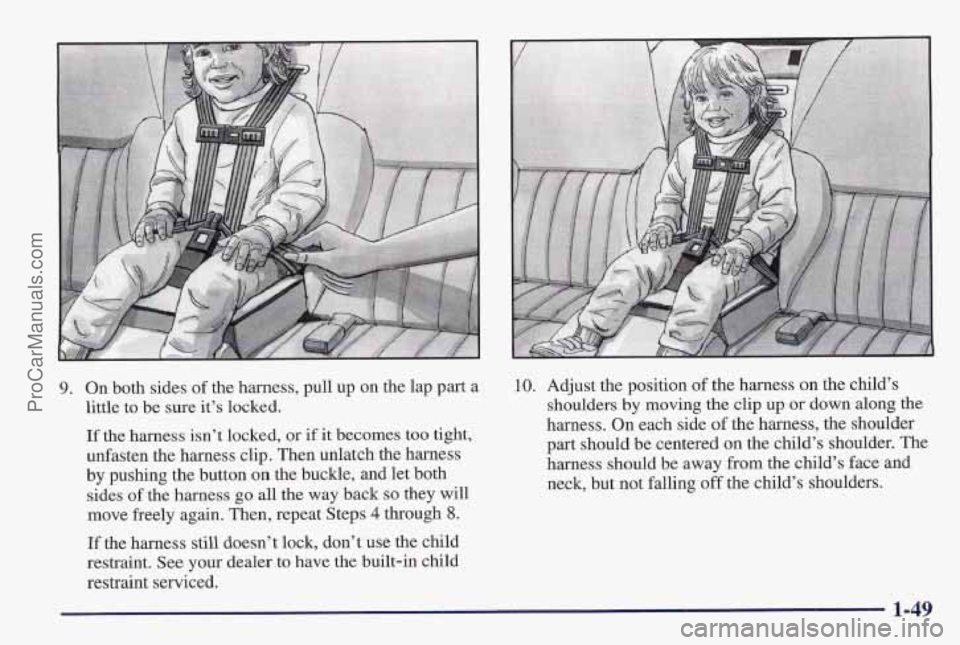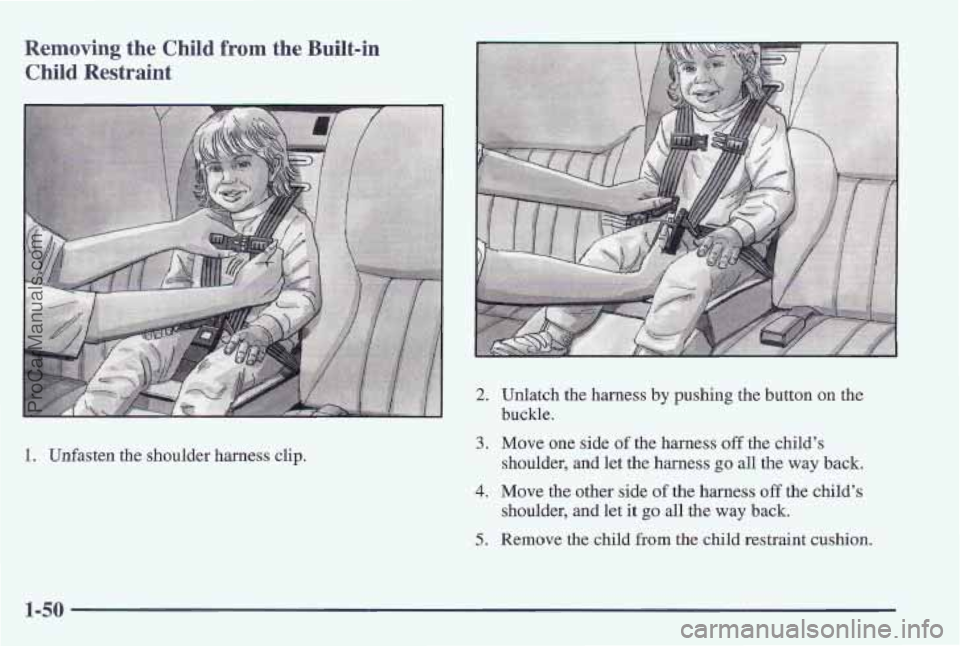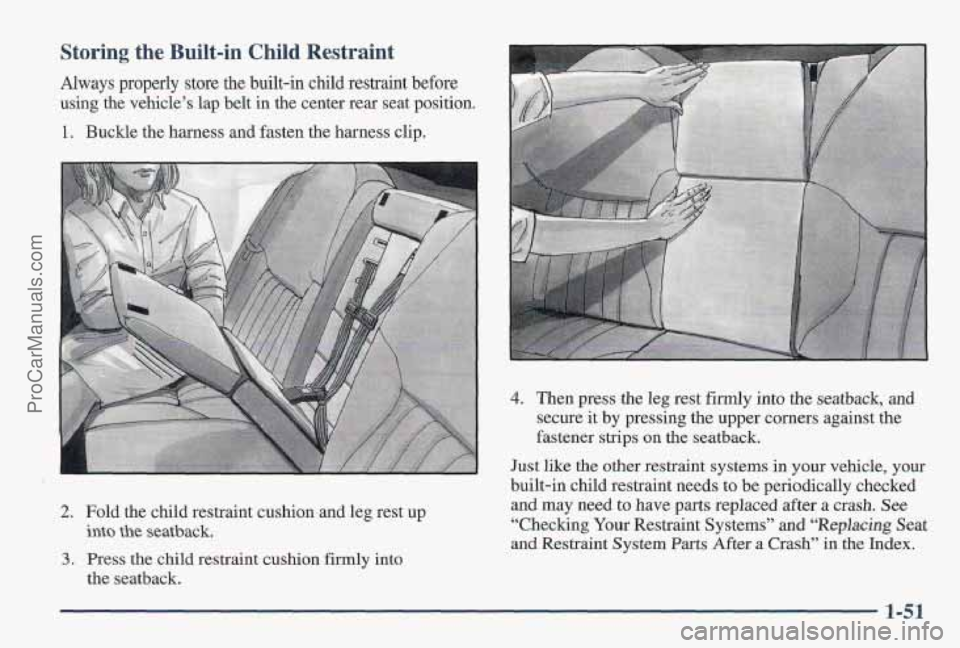PONTIAC PONTIAC 1997 Workshop Manual
PONTIAC 1997
PONTIAC
PONTIAC
https://www.carmanualsonline.info/img/50/58391/w960_58391-0.png
PONTIAC PONTIAC 1997 Workshop Manual
Trending: ABS, service, ECU, trailer, mirror controls, spark plugs, change language
Page 51 of 419
8. Move the harness up or down to the correct slot. The
correct slot is the one that will be at or just above the
top
of the child’s shoulder.
9. Twist the hamess slightly to ruute it through the
. correct slot.
10. Pull on the harness. Make sure it is properly routed
11. Repeat Steps 5 through 10 for the other side of
and isn’t twisted or
flipped over.
the harness. Be sure both sides
are adjusted to
the same height.
1-43
ProCarManuals.com
Page 52 of 419

12. Move the pad back against the child restraint
seatback.
Make sure the harness goes through the
slots in the pad that match the height adjustment
slots being used.
fastener
strip.
13, Press the upper edge of the pad against the
Securing a Child in the Built-in Child Restraint
-
Now that the harness is adjusted to the correct height for
your child, you’re ready to use the child restraint’s
harness (E) to secure your child.
Don’t use the vehicle’s safety belts.
Using the vehicle’s regular safety belts on a child
seated on the child restraint cushion can cause
serious injury
to the child in a sudden stop or
cra,sh.
If a child is the proper size for the built-in
child restraint, secure the child using the child
restraint’s harness. But children
who are too
large for the built-in child restraint should sit on
the vehicle’s regular seat and use the regular
safety belts.
WARNING! FAILURE TO FOLLOW THE
MANUFACTURER’S INSTRUCTIONS ON THE
USE OF THIS CHILD RESTRAINT SYSTEM
CAN RESULT IN YOUR CHILD STRIKING
THE
VEHICLE’S INTERIOR DURING A SUDDEN STOP
OR CRASH.
SNUGLY ADJUST
THE BELTS PROVIDED WITH
THIS CHILD RESTRAINT AROUND YOUR CHILD.
ProCarManuals.com
Page 53 of 419
1. If the left and right halves of the shoulder harness
clip
are fastened together, separate them.
2. If the lap-shoulder harness is buckled, unlatch it by
pushing the button on the buckle.
3. Place the child on the child restraint cushion.
1-45
ProCarManuals.com
Page 54 of 419
Page 55 of 419
7. Push the latch plate into the buckle until it clicks.
Pull on both latch plates to make sure they are
secure.
A green indicator will show in each latch
plate window
(G).
If the harness locks before the latch plate reaches the
buckle, let the harness
go all the way back so it will
move freely again. Then repeat Steps
6 and 7. Be
sure to keep the harness pulled all the way out until
you buckle it.
Once both sides of the lap-shoulder harness are
pulled out
of the retractor and buckled, the harness
will lock.
1-47
ProCarManuals.com
Page 56 of 419
8. Now fasten the left and right halves of the shoulder
harness clip together. The indicator window
(H) on
the clip will show green when the two halves are
fastened together. The purpose of this clip is to help
keep
the harness positioned on th’e child’s shoulders.
An unfastened shoulder harness clip won’t help
keep the harness in place on the ‘child’s shoulders.
If the harness isn’t on the child’s shoulders, it
won’t be able to restrain the child’s upper body
in a sudden stop or crash. The child could be
seriously injured. Make sure the harness clip
is
properly fastened.
1-48
ProCarManuals.com
Page 57 of 419
9. On both sides of the harness, pull up on the lap part a
little to be sure it’s locked.
If the harness isn’t locked, or if it becomes too tight,
unfasten the harness clip. Then unlatch the harness
by pushing the button
on the buckle, and let both
sides of the harness go all the way back
so they will
move freely again. Then, repeat Steps
4 through 8.
If the harness still doesn’t lock, don’t use the child
restraint. See your dealer to have the built-in child
restraint serviced. 10.
Adjust the position
of the harness on the child’s
shoulders by moving the clip up
or down along the
harness. On each side of the harness, the shoulder
part should be centered on the child’s shoulder. The
harness should be away from
the child’s face and
neck, but not falling
off the child’s shoulders.
1-49
ProCarManuals.com
Page 58 of 419
Removing the Child from the Built-in
Child Restraint
1. Unfasten the shoulder harness clip.
2. Unlatch the harness by pushing the button on the
buckle.
3. Move one side of the harness off the child’s
shoulder, and let the harness
go all the way back.
4. Move the other side of the harness off the child’s
shoulder, and let it
go all the way back.
5. Remove the child from the child restraint cushion.
1-50
ProCarManuals.com
Page 59 of 419
Storing the Built-in Child Restraint
Always properly store the built-in child restraint before
using the vehicle’s lap belt in the center rear seat position.
1. Buckle
the harness and fasten the harness clip.
2. Fold the child restraint cushion and leg rest up
into the seatback.
3. Press the child restraint cushion firmly into
the seatback.
4. Then press the leg rest firmly into the seatback, and
secure it by pressing the upper corners against the
fastener strips
on the seatback.
Just like the other restraint systems in your vehicle, your
built-in child restraint needs
to be periodically checked
and may need
to have parts replaced after a crash. See
“Checking Your Restraint Systems” and “Replacing Seat
and Restraint System Parts After a Crash” in the Index.
1-51
ProCarManuals.com
Page 60 of 419
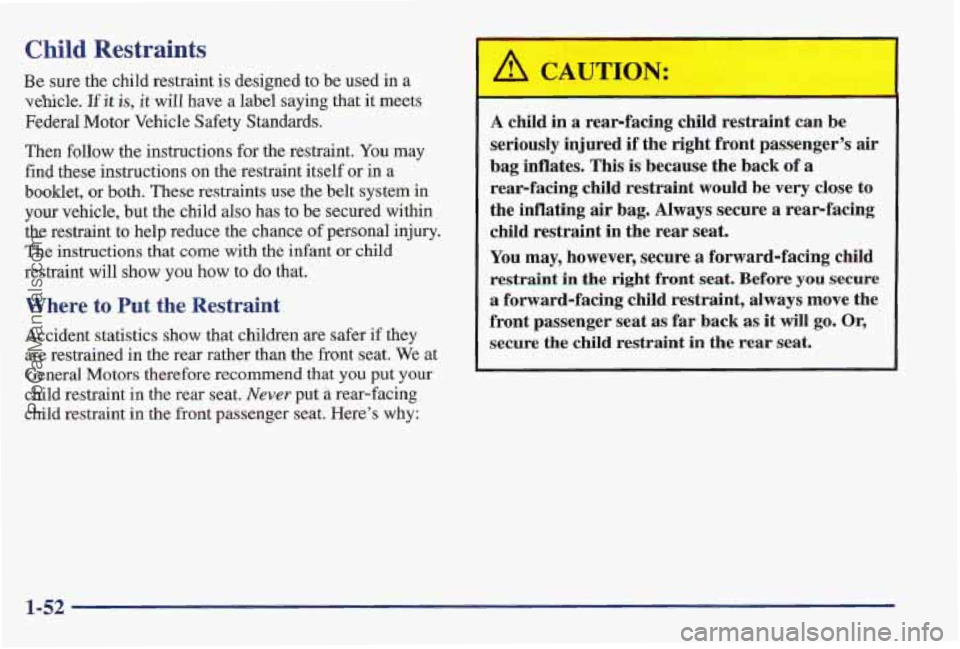
Child Restraints
Be sure the child restraint is designeld to be used in a
vehicle.
If it is, it will have a label saying that it meets
Federal Motor Vehicle Safety Standards.
Then
follow the instructions for the restraint. You may
find these instructions on the restraint itself or in a
booklet, or both. These restraints use the belt system in
your vehicle, but the child
also has to be secured within
the restraint to help reduce the chance
of personal injury,
The instructions that come with the infant or child
restraint will
show you how to dol that.
Where to Put the Restraint
Accident statistics show that children are safer if they
are restrained in the rear rather than the front
seat. We at
General Motors therefore recommen'd that
you put your
child restraint in the rear seat.
Never gut a rear-facing
child restraint in the front passenger seat. Here's
why:
A child in a rear-facing child restraint can be
seriously injured
if the right front passenger's air
bag inflates. This is because the
back of a
rear-facing child restraint would be very close to
the inflating air bag. Always secure
a rear-facing
child restraint
in the rear seat.
You may, however, secure a forward-facing child
restraint in the right front seat. Before you secure
a forward-facing child restraint, always move the
front passenger seat as far back as it will
go. Or,
secure the child restraint in the rear seat.
1-52
ProCarManuals.com
Trending: check engine light, four wheel drive, light, keyless entry, service schedule, transmission, change language
